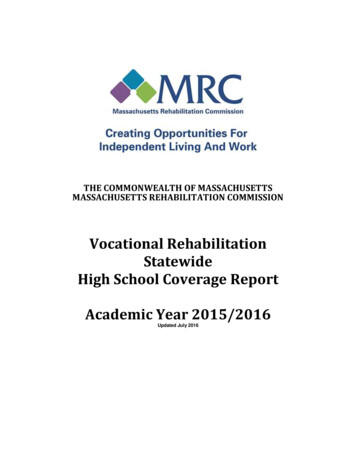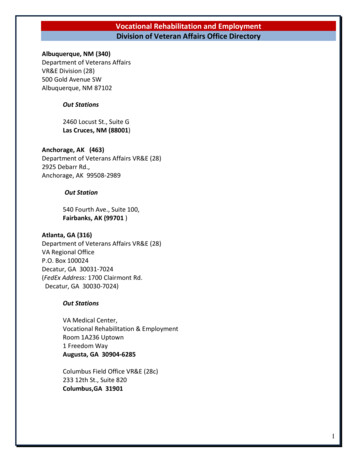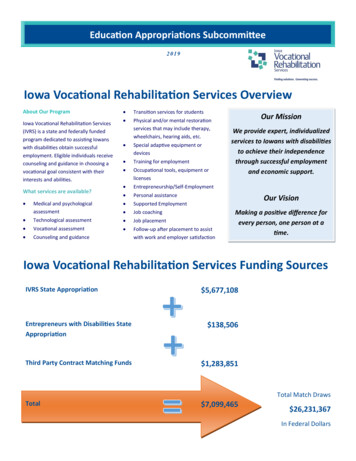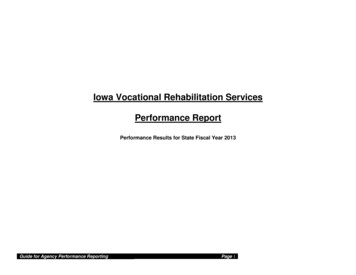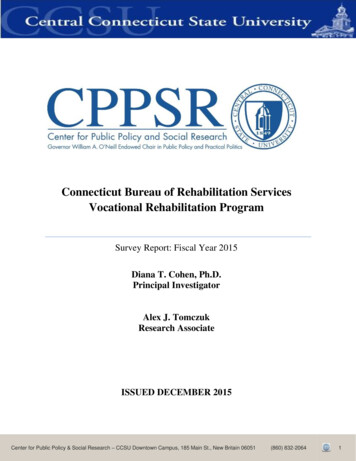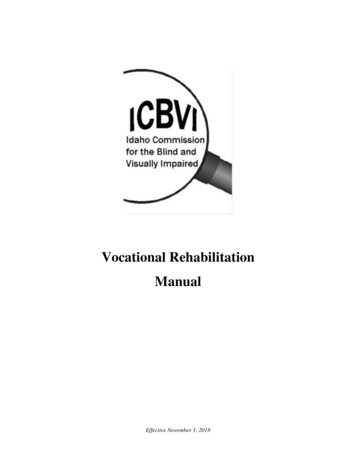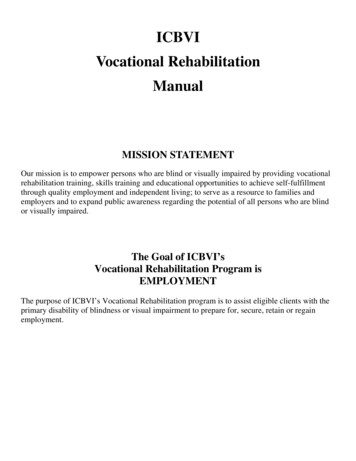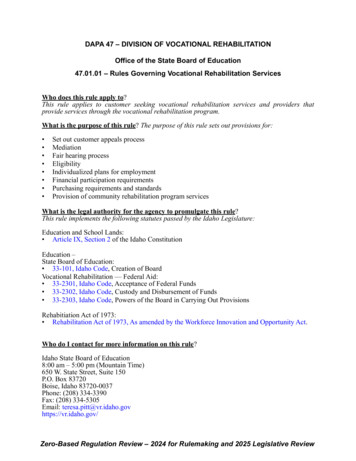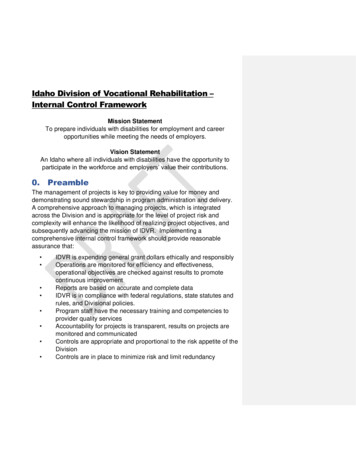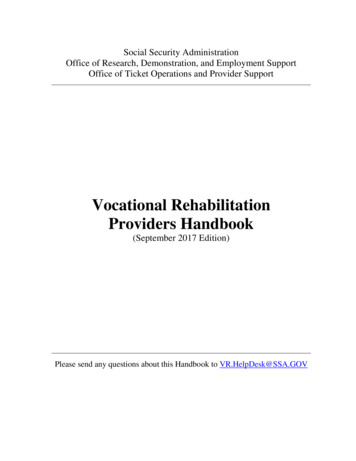
Transcription
Social Security AdministrationOffice of Research, Demonstration, and Employment SupportOffice of Ticket Operations and Provider SupportVocational RehabilitationProviders Handbook(September 2017 Edition)Please send any questions about this Handbook to VR.HelpDesk@SSA.GOV
Table of ContentsPreface. 5Purpose of the Handbook . 5Web-Based Ticket Portal for Cost Reimbursements and Ticket to Work Operations . 5Introduction to the Social Security Administration’s Vocational RehabilitationReimbursement Program . 6Background . 6Legislative Authority . 6Regulatory Authority . 6Purposes of the Program . 6Program History . 6SSA's Role . 7The VR Provider's Role . 8Requirements for Payment . 9General Requirements . 9Benefit Status . 9When Services Must Be Provided . 9Determining the Payment Period . 10Determining the Period of VR within the Payment Period . 11Post-employment Services . 12Services for which Reimbursement may be paid . 12General Services. 12Specific Services . 13Substantial Gainful Activity (SGA) . 14What is meant by SGA . 14What is meant by a Continuous Period of SGA . 15Basis for VR Reimbursement Claims . 17Continuous Period of SGA . 17Medical recovery during VR . 17Types of Claims . 19Initial Claim . 19Supplemental Claim . 19Reconsideration Claim . 19Submitting a Claim for Reimbursement . 20Processing the claim . 202
Completion of the SSA-199 . 21Timeframe for Submitting Claims . 25Claims Based on the Beneficiary's Completion of a Continuous Period of SGA . 25Claims Based on VR Medical Cessation (Section 301 Claims). 25VR Claim Documentation Requirements . 25Service Codes List . 27SSA Codes . 27RSA Codes . 29SGA Documentation. 30Benefit Status Documentation . 30Direct Costs Documentation . 30VR Services Documentation . 31Payment Appeals Process . 31Requesting a Reconsideration . 31Reconsideration Decision . 31Cost Containment Policies . 32Similar/Comparable Benefits . 33Exceptions . 33Direct and Indirect Costs . 33Direct Costs . 33Indirect Costs . 34Advance Funding . 34Cost Formulas . 34Payment Validation Reviews . 42PVR Documentation Requirements . 43Submitting Documentation to SSA. 44Technician’s Action . 44Requests for Reconsiderations . 44Ticket To Work . 45How the Ticket Program Works . 45Who is eligible for a Ticket? . 46Ticket Program Participation . 46State VR Agency Participation . 46Beneficiary Participation . 47Selecting a Provider Using the Ticket Program Manager . 48Payment Options Available to State VR Agencies and ENs . 483
Payment Options Available to an EN . 48Payment Options Available to a State VR Agency . 49Overview of In-Use SVR and Ticket Assignment . 50In-Use SVR Status . 50Eligibility and Assignability . 50Proof of a Beneficiary’s Decision to Assign a Ticket. 51Process for a State VR to place a Ticket “In-Use SVR”. 51Electronic Data File Requirements. 51The Importance of Submitting the Data File . 51Terminating In-Use SVR Status or Unassigning a Ticket . 52Changing the Cost Reimbursement Payment Option to Ticket Assignment . 53When Ticket Use Begins and Ends . 54When Using a Ticket Ends . 54The Effect of Ticket Terminations . 55Eligibility for a New Ticket . 56When a Beneficiary Seeks VR Services While the Ticket Is Assigned to an EN . 56Suspension of Medical Reviews for Beneficiaries Who Are Using a Ticket . 57Annual Periodic Reports from MAXIMUS . 57The Redbook – A Guide to Work Incentives. 58Protection and Advocacy for Beneficiaries of Social Security (PABSS) . 58Dictionary of Occupational Titles . 584
PrefacePurpose of the HandbookThis handbook is an instructional guide for State Vocational Rehabilitation (VR) agenciesserving Social Security Disability Insurance beneficiaries and Supplemental SecurityIncome recipients under the Social Security Administration, VR Cost Reimbursement andTicket to Work programs.Web-Based Ticket Portal for Cost Reimbursements and Ticket to Work OperationsThe Social Security Administration’s (SSA) web-based Ticket Portal is available to StateVR agency personnel who have obtained Federal suitability clearance. Agency personnelmay request access to the Ticket Portal for use in carrying out key aspects of SSA’s returnto work programs, such as assigning or placing a Ticket in use or requestingreimbursements or Ticket payments. Agency personnel with suitability clearance will gainaccess to the Ticket Portal User Guide and may request technical assistance with Portalusage.The VRA Operations Team in the Office of Research, Development, and EmploymentSupport is responsible for the contents of this handbook.5
Introduction to the Social Security Administration’s VocationalRehabilitation Reimbursement ProgramBackgroundThe Social Security Administration (SSA) administers a Vocational Rehabilitation (VR)Reimbursement Program to help people with disabilities go to work. Under this program,SSA reimburses State VR agencies for the costs of the services they provide to beneficiarieswith disabilities if such services result in the person's achieving work at a specified earningslevel.Legislative AuthorityThe Social Security Act (the Act) contains the legislative authority for SSA's VR program.Section 222(d) of the Act provides the authority for SSA to reimburse State VR agenciesfor the cost of rehabilitation services to Social Security Disability Insurance (SSDI)beneficiaries. Section 1615 of the Act provides the authority to reimburse the cost ofservices provided to disabled or blind Supplemental Security Income (SSI) recipients.Regulatory AuthoritySSA published the initial regulations to implement this legislation in 1983. The regulationsgoverning SSA's VR program are contained in the Code of Federal Regulations (CFR) at 20CFR 404.2101 through 404.2127 for the SSDI program and 20 CFR 416.2201 through416.2227 for the SSI program.Purposes of the ProgramThe purpose of SSA's VR Cost Reimbursement Program is to: Make VR services more readily available to disabled or blind Social Securitybeneficiaries and recipients; and Achieve estimated savings for the Social Security title II trust funds and the titleXVI general revenue fund.We reimburse State VR agencies from the title II trust fund for VR services to SSDIbeneficiaries and from the title XVI general fund for services to SSI recipients. For ease ofreference throughout this handbook, we will use the term disability beneficiaries to refer toboth SSDI beneficiaries and SSI recipients unless there is a difference between the twoprograms in how to handle reimbursement claims. Savings to the trust or general fundsaccrue as people go back to work and reduce reliance on monthly Federal cash benefits.Program HistoryCongress established the current VR Reimbursement Program in 1981 to encourage StateVR agencies to provide services that would result in work by disability beneficiaries. Priorto 1981, SSA awarded State VR agencies block grants to work with Social Security clients.However, this program did not provide information about how the funds used on an6
individual case basis. Consequently, SSA could not determine whether the VR services forwhich it was paying resulted in work. To address this issue, Congress changed SSA's VRprogram to make it more result oriented.Under the current program, Social Security trust funds and general revenues pay for VRservices in those cases in which the services contribute to the performance of substantialwork for a period of nine continuous months.Although the primary focus of the VR program is to help people with disabilities go towork, there is another instance when SSA pays for VR services. It is when an individualcontinues with a VR program after SSA determines the person's disability ceased becauseof medical recovery.The primary conditions for reimbursement are as follows: The individual must be a disability beneficiary or SSI recipient at the time theservices are provided; The services must have contributed to the person's going to work at a specifiedearnings level referred to as the substantial gainful activity (SGA) amount; The services must be determined to be reasonable and necessary; and Estimated savings to the trust or general funds must be achieved as a result of theindividual going to work and reducing or eliminating benefit dependency.* The services are provided to a person who medically recovers from a disability butcontinues to receive benefits because of participation in an approved VR program,which will increase the likelihood of permanent removal from the disability rolls.*By law, payments made to providers under the VR program cannot exceed the estimatedsavings to these funds should the beneficiary leave the benefit rolls.SSA's RoleSSA reimburses providers for the costs of VR services if the provider furnishes servicesthat result in the individual performing SGA along with the other requirements. SSA doesnot directly provide the rehabilitation services. State VR agencies furnish the services.State VR agencies operate under regulations issued by the Rehabilitation ServicesAdministration (RSA) and use existing rehabilitation definitions and practices includingRSA cost containment guidelines.The Reimbursement ProcessState VR agencies may submit claims to SSA for the costs of rehabilitation services if theindividual successfully completes a rehabilitation program or medically recovers whilecontinuing to participate in VR. SSA reviews these claims to ensure they meet the paymentrequirements. Once the VR meets the requirements, SSA will reimburse the provider forthe reasonable and necessary costs of its services.7
The VR Provider's RoleThe State VR agency is responsible for assessing the person's rehabilitation potential,deciding to accept the person as a client, notifying SSA if it accepts the person as a client,and arranging for VR services.For accepted individuals, the provider is responsible for developing a rehabilitationprogram for the beneficiary that will result in the individual attaining work at the SGA levelfor a continuous period of at least 9 months. The provider is responsible for eitherfurnishing the services itself or coordinating the delivery of such services throughsubcontractors or other sources. Once the rehabilitation program is completed and theclient has worked at the SGA level for a continuous period of at least 9 months, theprovider is responsible for submitting a properly documented claim for payment to SSA.The Referral Process (Repealed Nationwide as of November 1, 2003)Full implementation of the Ticket to Work program was November 1, 2003 in all States andterritories, and the authority to refer disability applicants or beneficiaries was repealednationwide.Title XVI recipients who have not attained the age of 16 will continue to be referred to theappropriate State agency administering the State program under title V of the SocialSecurity Act.8
Requirements for PaymentGeneral RequirementsSSA will reimburse a State vocational rehabilitation (VR) agency for the reasonable andnecessary costs incurred in providing VR services to a Social Security Disability Insuranceor Supplemental Security Income disability or blindness beneficiary. The primaryconditions for paying a provider for the cost of such services are as follows: The individual served must be a disability beneficiary at the time the services wereprovided.The services must have contributed to the beneficiary's employment at the SGAlevel.The services must be determined to be reasonable and necessary; andThere must be estimated savings to the trust or general funds from the person’sreduced reliance on program benefits. (The amount that can be paid to a VRprovider may be limited in situations where the anticipated savings to the trust fundand general fund, is less than the amount claimed by the provider.)The only other way SSA will make payments under VR services, is a 301 claim. Thisinvolves payments to providers in a case where a person medically recovers whileparticipating in an approved VR program.Benefit StatusAs indicated above, an individual must be a disability beneficiary at the time the serviceswere provided. This means that the services must have been provided during a month inwhich the individual met all requirements for SSDI benefits or was eligible for
This handbook is an instructional guide for State Vocational Rehabilitation (VR) agencies serving Social Security Disability Insurance beneficiaries and Supplemental Security Income recipients under the Social Security Administr
